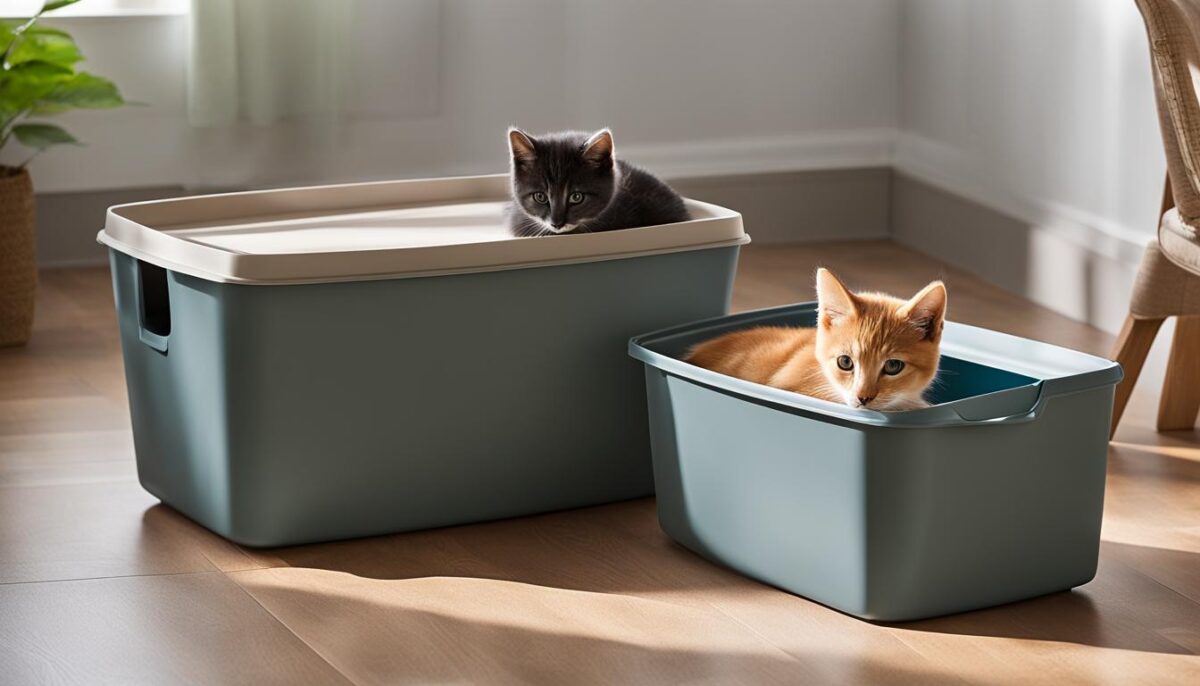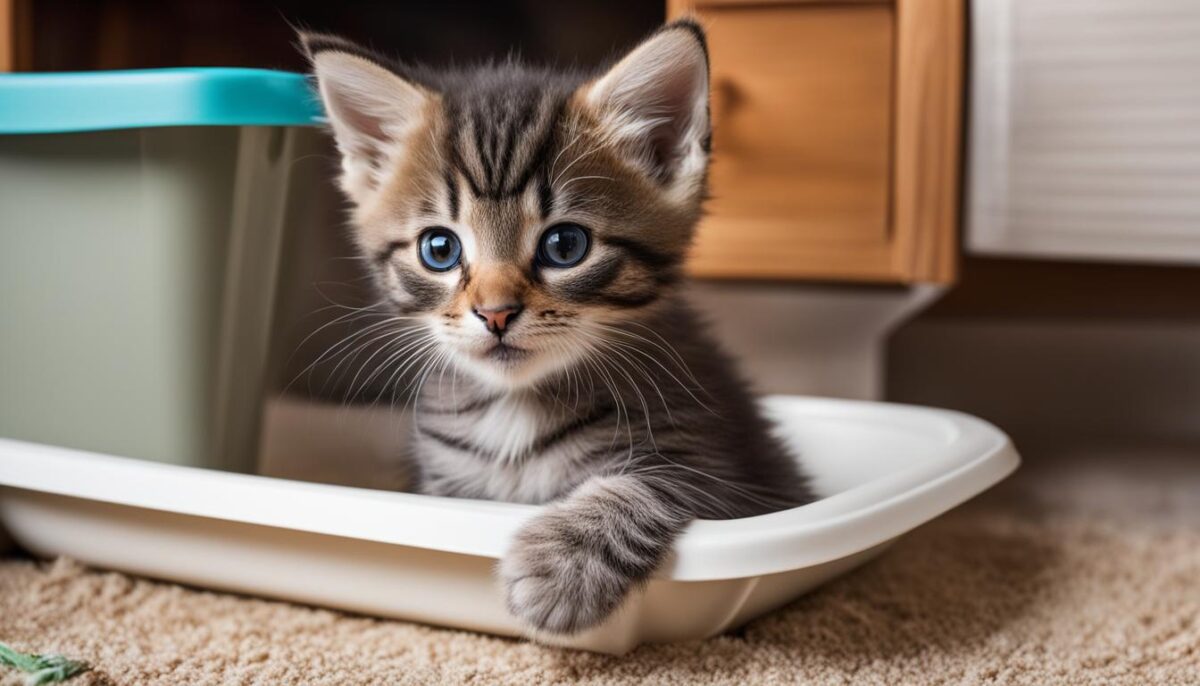If you’re thinking of adopting a cat, you might be wondering about cat potty training. After all, keeping your home clean is important! The good news is litter training kittens is usually simple. Cats are smart. They can learn where to go to the bathroom quickly. But don’t worry if your new friend is a little confused at first. With love and the right steps, your cat will figure it out.
Before your cat comes home, make sure you have everything ready. This means a litter box and some litter. Then, scoop and change the litter often. Create a spot just for your cat that is quiet and safe. This way, they’ll know where to go to do their business. So, ready to learn more? Let’s make cat potty training fun and easy!
Key Takeaways
- Getting a new cat is exciting, and teaching them to use a litter box is part of the journey.
- Set up their litter box before they arrive, so they have a special place to go.
- Keep your home clean by helping your cat know where their bathroom is.
- With patience and some easy tips, your cat will learn quickly.
- Remember to give them love while they are learning.
Understanding Your Kitten’s Natural Instincts
When little kittens come into the world, they do things that may seem super smart! They have natural cat behavior that tells them what to do, just like when you know it’s time to play or eat. One thing kittens are great at is figuring out where to go when they need to. But how do they know?
Why Kittens Seek Out Sandy Areas
Imagine wanting to build a sandcastle. Where would you go? To the sandbox, right? Kittens feel the same way about where they go potty. They look for sandy spots because it’s soft and easy to dig. That’s why they like litter boxes with litter that feels like sand. It’s all part of their kitten litter habits.
The Role of the Mother Cat in Early Training
Do you remember how you learned to tie your shoes? Someone had to show you the ropes, probably over and over. Kittens have a mom—the mother cat—who shows them many things, including early litter box training. She will scratch at the litter to show them how to do it. It’s like when your family helps you learn new things.
So, if you see kittens or a new cat scratching in the litter, know it’s just them being smart and doing what feels right to them. They understand their world, and with a little time, they’ll get even better at it!
Preparing for Success with the Right Supplies
Getting your little furry buddy all set up is super important for teaching them clean litter habits. Let’s find a kitten-friendly litter box and the best litter to fill it with!
Finding the Perfect Litter Box Size
Your new kitten is small, and so should be their litter box! Choose one that’s about the size of a piece of paper – 13 by 9 inches is just right. As your kitten grows like a weed, you’ll switch to a big-kid box. It’s a good idea to have one more box than the number of cats you have. So, if you have one kitten, go with two boxes!
Selecting the Preferred Type of Litter
Picking litter can be kind of like trying new ice cream flavors – you’ll want to see which one your kitten likes the best! Some kitties like clumping litter because it makes scooping easy for you. Others might prefer non-clumping litter because it’s softer on their tiny paws. Keep in mind, some litters smell funny, kind of like food, which might be a no-go for your kitten. Try a few and you’ll find the purr-fect match.
- Soft texture for sensitive paws? Check!
- Litter that doesn’t smell like snacks? Check!
- A quiet, easy-to-find spot for the box? Double-check!
Litter Trained Cat: The Basics of Effective Training
Getting your kitten to use the litter box is easy when you know how. Let’s learn the cat potty training steps together, so you can help your new friend with their kitten bathroom habits. It’s all about being kind and keeping up with training consistency. Are you ready? Here are the simple steps!
Introducing Your Kitten to the Litter Box
First things first, show your little kitten all the spots where you have set up litter boxes. Let them smell each one. This helps them know it’s a safe place. Then, after their meals, drinks, or naps, place your kitten gently in the box. This will help them understand where they should go when they need to use the bathroom. Remember to give a small treat when they do the right thing in their litter box. It will make them happy and they will remember to use the box again!
How Often to Guide Your Kitten to the Box
It’s important to show your kitten the litter box many times. Every time they finish eating or wake up from a nap, take them to the box. This helps them remember where the bathroom is. It’s just like when you were little and learning to use the potty yourself! Just have patience and keep showing them where to go, and they will get it soon.
| What to Do | Time to Guide Them |
|---|---|
| After Eating | Right Away |
| After Drinking | Within a Few Minutes |
| After Waking Up | Immediately |
By following these simple steps and being consistent, your kitten will learn their bathroom habits before you know it. And if they make a little mistake, it’s okay! Just clean up and try again. You’ve got this!
Creating a Positive Litter Box Environment
When your kitty feels happy and safe, they use their litter box just like they should! So, let’s make sure their litter spot is the best it can be. Where you put the box and how it feels to them can make a big difference. You want to give your furry pal a good space that makes using their box easy and stress-free.
Strategic Litter Box Placement in Your Home
The perfect spot for the box is a quiet corner where noises won’t scare your pet. Think about where you like to relax; your cat wants a calm place too. It’s like picking the best seat in a library, where it’s nice and peaceful. If the box is too hard to find or too close to where they eat, they might not use it. And remember to have a little light there, so they’re not in the dark. Kittens especially need to see where they’re going!
Making Litter Boxes Accessible and Inviting
Keep the door open to where you put the box so your cat can go in and out easily. No one likes a blocked path, right? And make it comfy for them, kind of how you fluff your pillow before bed. If your kitten is still learning, it’s like when you first learn to ride a bike; start on a straight path, not a hill. Keep them in a simple, small space without carpets at first. As they grow, make sure they can still fit and reach their box without a big jump. A happy cat means a happy home!
FAQ
How do I start litter training my kitten?
Begin by introducing your kitten to the litter box in a quiet, accessible place. Gently place them inside so they can sniff and explore. After meals, drinks, or waking up, guide them to the box until they start using it on their own. Reward with treats for successful use, but avoid scolding for accidents.
At what age should I start litter box training?
Kittens can begin litter box training at about 4 weeks old. Before that, their mother will help them with their bathroom needs. For older adopted cats, you can start as soon as they arrive at your home.
How many litter boxes do I need for my cat?
You should have one litter box per cat, plus one extra, to prevent competition and ensure comfort. This also helps with home cleanliness and maintaining a stress-free environment for your feline friend.
How can I make the litter box inviting for my kitten?
Choose a kitten-friendly litter box—small and shallow for easy access. Select a type of litter that’s soft and appeals to your kitten’s preferences, avoiding scented options that might deter them. Place the box in a serene area where your kitten feels safe and can locate it easily.
Can I train an older cat to use a litter box?
Absolutely! Older cats can still learn to use a litter box. Introduce them to the box in the same way as kittens, by guiding them and rewarding them for proper use. Remember, patience and positive reinforcement are key.
Should the litter box be in a lighted area?
Yes, placing the litter box in a well-lit area or providing a night light can help your kitten find the litter box in the dark and feel secure. Avoiding loud, high-traffic areas contributes to a positive litter box environment as well.
Why does my cat prefer sandy litter?
Cats have a natural instinct to dig and bury their waste, and sandy litter closely mimics their preferred outdoor conditions. This texture allows for easy digging and covering, making it a go-to choice for many feline friends.
What should I do if my kitten has an accident outside the litter box?
Clean the area thoroughly with an enzymatic cleaner to remove odors and discourage repeat behavior. Never yell at your kitten; instead, patiently continue guiding them to the litter box and positively reinforce correct usage.
How can I make sure my cat maintains clean litter habits?
Keep the litter box clean by scooping it regularly and changing the litter as needed. Encourage your cat’s natural behavior by providing the preferred type of litter and maintaining an inviting litter box environment.
What do I need to prepare before adopting a cat to ensure they are litter trained?
Before bringing your new cat home, set up a suitable litter box and choose the right type of litter. Ensure the litter box is placed in a quiet, reachable spot and familiarize yourself with litter training techniques for smooth acclimation to their new surroundings.


